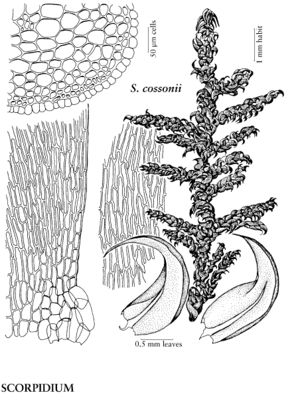Scorpidium
Laubm. Deutschl. 3: 570. 1899.
| Taxon | Illustrator ⠉ | |
|---|---|---|
 | Scorpidium cossonii | Patricia M. Eckel |
 | Scorpidium revolvens | Patricia M. Eckel |
 | Scorpidium scorpioides | Patricia M. Eckel |
Plants medium-sized to very large, green, brownish yellow, brownish to blackish red, or red. Stems irregularly branched to pinnate, ± in one plane; hyalodermis at least partially present, central strand weak or rarely absent; pseudoparaphyllia broad, foliose; rhizoids or rhizoid initials on stem, at or just below leaf insertions; axillary hair distal cells 2–9 (–11), hyaline. Stem-leaves ovatelanceolate to broadly ovate, sometimes almost orbicular, gradually or abruptly narrowed to apex, suddenly curved distally, sometimes indistinctly so or ± straight, concave or strongly concave, not or hardly plicate; base not or hardly decurrent; margins entire proximally, finely denticulate or ± entire near apex; apex obtuse, apiculate, acute, or acuminate; costa single or double, short or ending beyond mid leaf, rarely ecostate; alar cells differentiated, few, short to long-rectangular, strongly inflated, hyaline, walls thin, region distinctly delimited, small, transversely triangular, from margins at most 50% distance to costa; medial laminal cell-walls thin to strongly incrassate, porose or not. Sexual condition dioicous or autoicous; inner perichaetial leaves plicate; vaginula with paraphyses present. Capsule with annulus separating; exostome external surface reticulate or partly, rarely entirely, cross-striolate basally, margins slightly dentate distally. Spores 12–21 µm.
Distribution
North America, South America, Eurasia, s Africa, Pacific Islands (New Zealand), Pacific Islands (Papua New Guinea), Australia, Antarctica
Discussion
Species 3 (3 in the flora).
Scorpidium is characterized by a hyalodermis of inflated, thin-walled epidermal cells, which is present in at least part of the stem circumference. Unlike Hamatocaulis, Scorpidium has at least a weak central strand, except in very weak plants. These plants have small alar regions consisting of a few (2–20) inflated and thin-walled cells that are sharply delimited from the surrounding cells. Their stem leaves are normally smooth and, like those of Hamatocaulis, from an erectopatent to patent base suddenly curved distally, except in most expressions of S. scorpioides. Scorpidium is found in mineral-rich to intermediately mineral-rich and normally nutrient-poor habitats. When mineral-rich, these habitats are mostly rich in calcium.
Selected References
None.
Key
| 1 | Stem leaves strongly concave, almost orbicular to broadly ovate-lanceolate, suddenly curved distally or rarely straight; apices obtuse, usually apiculate, acute, or acuminate; costae double or occasionally single, rarely ecostate, rarely reaching beyond mid leaf; stem hyalodermis often incomplete; stem leaves (0.7-)1-2.4 mm wide. | Scorpidium scorpioides |
| 1 | Stem leaves concave, ovate to ovate-lanceolate, ± suddenly curved distally; apices short- to long-acuminate, sometimes apiculate; costae single, ending beyond mid leaf; stem hyalodermis complete; stem leaves 0.5-1.1 mm wide | > 2 |
| 2 | Sexual condition autoicous; stem leaf medial laminal cells 61-140(-179) µm, cell ends short or long fusiform-narrowed; exostome external surface more than 40-50% cross striolate basally. | Scorpidium revolvens |
| 2 | Sexual condition dioicous; stem leaf medial laminal cells 14-95(-120) µm, cell ends square, rounded, or short fusiform-narrowed; exostome external surface more than 70% dotted basally. | Scorpidium cossonii |